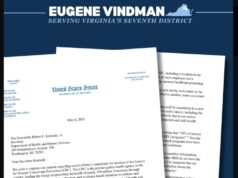UPDATE: The person, Carrie Johnson (Arlington County Democratic Committee – ACDC – “list lady”), who put together (and presented) the analysis I discuss below for the ACDC Steering Committee, this morning commented on Blue Virginia:
“I urged Steering Committee members to resist the temptation of simplistic interpretations, given the complexities of assigning party IDs to a significant number of Arlington voters who have a habit of voting in either party’s primary depending on the contests in a given year. In fact just about half of those 1992 mostly-Republican voters had voted in at least one Democratic primary before June 14. (Crossovers can go both ways: The report also shows that 15% of the voters in the March 1 Republican primary are identified as Democrats.)”
Also, I spoke with Carrie Johnson this morning, and she encouraged me to put this post back up, with a few caveats (see below). I very much appreciate the work Carrie Johnson does, and agree with her that it’s not a simple answer who is a Democrat or Republican, why people vote for the candidates they do, etc, etc. With that, here are her caveats, followed by en edited version of the original post, with more detail and caveats added, per my conversation with Carrie Johnson.
- In a state without registration by party, party IDs have to be deduced from voters’ turnout, canvasses and other data. Arlington has a number of longtime residents who take part in just about every primary of either party that interests them. Several hundred of the June 14 voters fall into that group. Various formulas label some as R and others as D. The best label might be “constant voter”. Their attendance is predictable; it’s harder to guess how they voted.
- The June 14 turnout, while larger than the 2015 County Board primary, was in some ways more concentrated, with high proportions of older voters in single-family precincts. Turnout in minority-majority precincts was very low. A perennial challenge is how to widen participation in these local contests.
- Looking ahead, one notable factor is the large number of first-time primary voters March 1. They tend to be younger, more concentrated in transit corridors, and on the GOP side more heavily male. What will they do in November?
********************************************
We now have more detailed results (see below) from the Arlington County Board Democratic primary held on June 14 between incumbent Libby Garvey and challenger Erik Gutshall. One question was whether Republicans, encouraged by GOP County Board member John Vihstadt and others, would turn out in significant numbers to vote in the Democratic primary for Libby Garvey over Erik Gutshall. The following numbers, put together by Carrie Johnson of ACDC, indicate that this may have been the case. A few highlights:
- Libby Garvey won the June 14 Democratic primary by 1,484 votes over Erik Gutshall.
- Of the 15,240 voters who turned out, 1,992 (13%) appear to have been either “strong” (1,376) or “leaning” (616) Republican.
- At least based on anecdotal evidence, it seems likely that most of those (apparent) Republicans would have turned out to vote for Garvey, as Garvey’s Republican ally John Vihstadt was busy urging them to turn out for her, and also given that Garvey backed Vihstadt over Democratic nominee Alan Howze for County Board, held a fundraiser with former Rep. Tom Davis (R), etc, etc.
- Another 530 voters were “unidentified;” not sure how they would have voted.
- In the end, there appears to have been a greater number of likely Republican votes cast (1,992) on June 14 than Garvey’s total margin of victory (1,484). That, in turn, implies that Gutshall could have won the Democratic primary if Democrats ONLY – no Republicans, independents, etc. – had voted. Likewise, of course, Gutshall could have won if: a) a higher percentage of the Democrats who actually turned out had voted for him; b) more Democrats had turned out and voted for him.
- It’s probably more accurate to conclude that Erik Gutshall’s loss to Libby Garvey was due to a number of factors, including the fact that he was a first-time candidate, got off to a late start, and arguably made some mistakes (of course, how many candidates run perfect campaigns?). Based on Carrie Johnson’s numbers, one of those factors appears to have been that nearly 2,000 likely Republicans voted in the Democratic primary. Of course, it’s theoretically possible that a significant percentage of the Republicans might have voted for Gutshall, not Garvey, but…other than neighbors and friends of Gutshall’s, it seems more credible that most would have voted for Garvey. We’ll probably never know the exact numbers, and Garvey might have won the election regardless, but it’s interesting to consider what might have happened if, for instance, Virginia had party registration and closed primaries.
- It also would have been interesting to see how many Republicans turned out for Garvey if this had been a “firehouse caucus” or other, non-primary method of selecting the Democratic nominee.
In the end, this is probably more interesting for political junkies (like me) than normal people — kind of “inside baseball.” Also, again, this entire discussion would have been moot if Gutshall had gotten more Democrats to turn out, or had received a larger share of the much-larger Democratic share of the electorate to vote for him. So there’s that…
By the way, it’s interesting to see how old the electorate was (51% of voters were 60+; 35% between 40 and 59; just 15% under age 40). Compare that to the Democratic presidential primary on March 1, in which 38% were under 40, and only 27% age 60+. Yet more evidence that young people are not particularly interested in or connected with local politics.
Also note that the largest percentage (26.4%) by zip code in the Democratic County Board primary was in wealthy, suburban, white, far-northern Arlington (22207) — and that was Garvey territory, according to this map by Ben Tribbett. Again, note the contrast with the March 1 Democratic presidential primary, in which a higher share of voters were from racially and ethnically diverse south Arlington (22202, 22203, 22204, 22206). Last but not least, note the dramatic difference in the percentage of Democratic voters living in multi-unit buildings in the March 1 presidential primary (42%) and the June 14 County Board primary (23%). Fascinating…















